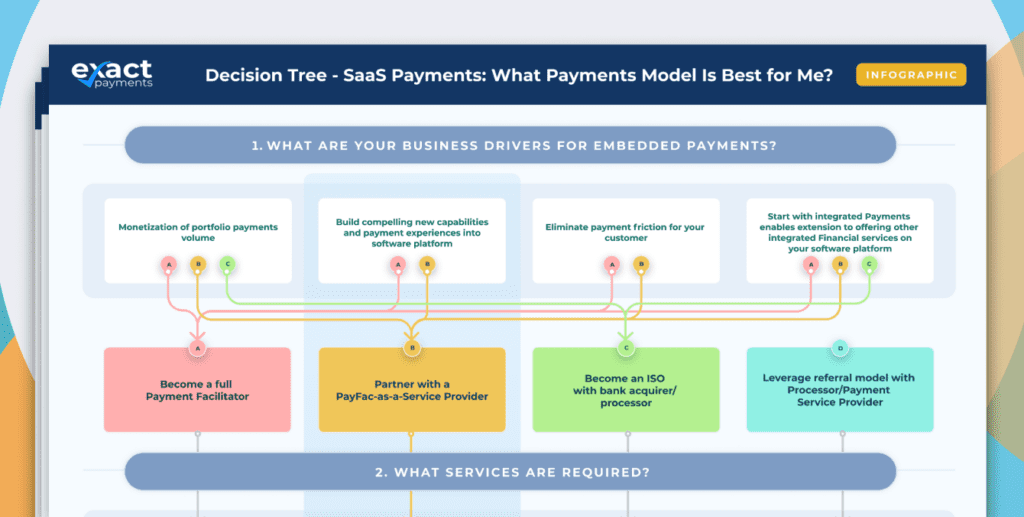Making Money as a PayFac: Understanding Fees and PayFac Pricing Models

If you’re a SaaS company that aspires to monetize payments as a payment facilitator (PayFac) or by using a PayFac-as-a-Service solution (PFaaS), knowledge of payment processing fees and PayFac pricing models is crucial to your success. The more you understand processing fees and the various pricing structures — what they consist of, how they’re calculated, and how they’re marked up—the more you can boost your profit margin.
In this article, we’ll dive into the world of payment processing fees and discuss different pricing models that your business can leverage.
What Are Payment Processing Fees?
With a PFaaS solution, payment processing fees, or merchant fees, are charged to merchants by the PFaaS provider in partnership with the SaaS provider. These fees are assessed every month via a merchant statement that lists out account activity and costs incurred.
If you’ve looked at a merchant statement before, you know that it can be quite complex. They typically include a long list of itemized transactions with varying rates, as well as additional charges for payment-related services or products.

Here are the standard fees included in a merchant statement:
1. Interchange fees
Interchange fees are the per-transaction costs charged by the credit card brands (such as Visa and Mastercard). Every transaction qualifies for a specific rate depending on its level of risk.
Interchange fees are typically structured as a percentage of the total purchase price plus a fixed per-transaction fee, such as 2.1% + $0.10.
2. Dues and Assessment fees
Assessment fees, also known as dues and assessments or just assessments, are a set of fees paid to the card network. Assessments are not negotiable but can fluctuate and are reviewed by the networks twice a year. The card networks set assessments, which are, therefore, the same for all processors. There are per-transaction, monthly, and quarterly assessment fees charged by the networks.
While not standard across all card networks, assessments typically consist of a percentage fee, a flat fee, and a card network fee (e.g., a cross-border transaction fee) and are often paid on a per-transaction basis for processing transactions on a network’s rails.
3. Chargeback fees
A chargeback is a customer-filed dispute that results in the reversal of funds. The merchant’s acquiring bank charges a fee for every chargeback, which can add up fast if the merchant hasn’t taken steps to prevent chargebacks.
4. PCI fees
Most merchant services providers charge a fee for assisting with Payment Card Industry Data Security Standard (PCI DSS) compliance. They also assess non-compliance fees should the merchant fall out of compliance.
5. Product and feature fees
Payment features like network tokenization, 3D Secure authentication, and account updater incur additional fees.
How Interchange Fees Are Determined
Every transaction qualifies for a specific rate based on several risk-related variables. These rates are published by the card brands twice per year in lengthy rate schedules.
The sheer volume of rate categories and fees is quite extensive. Here are some of the most common variables that impact interchange costs:
- Card present vs. card-not-present
Transactions in which the card is not physically present (e.g., online or over the phone) are inherently more risky and thus cost more than card-present transactions.
- Debit vs. credit
Credit cards are more expensive to process since they carry a greater risk of fraud.
- Merchant category code (MCC)
MCC codes classify merchants based on the type of organization. Some industries, such as nonprofits, qualify for lower pricing, while other riskier businesses would pay higher rates.
- Credit card type
Some credit card brands like American Express charge higher fees. American Express justifies charging merchants a higher processing fee to cover the benefits they offer to their cardholders by asserting they attract more affluent cardholders who charge higher priced items.
- Commercial versus consumer cards
Commercial cards charge higher interchange fees than those issued to an individual.
- Type of data sent with transactions
When a transaction is processed, several data points are passed along to the card processor, such as the card’s CVV and cardholder address. You can qualify for lower processing rates by leveraging Level 2 or Level 3 processing, in which you provide more robust data with the typical transaction data, such as invoice and order numbers, and item codes and descriptions.
Wholesale vs. Markup: How Payments Are Monetized
As a SaaS payment platform, your goal is to earn revenue from payment processing fees. To do so, you need to mark up the wholesale costs received by your PFaaS provider.
The markup is a flexible rate or fee added to the wholesale rate, guided by your specific pricing strategy. The total marked-up cost is what your merchant sees on their statement.
When formulating a pricing structure, software platforms and their PayFac-as-a-solution providers must take wholesale pricing into account. The PayFac provider is typically responsible for passing along collected fees to the card brands and banks, and they need to be able to cover these costs while also making a profit for themselves and the SaaS company.
Pricing Models Offered By PFaaS Providers
SaaS companies have several options for monetizing payments when working with a PFaaS provider. PFaaS providers may offer you a flat rate, interchange plus, or tiered model to determine your wholesale cost. From there, software providers have the flexibility to add a markup in any structure they choose as a part of their pricing strategy.
The most common pricing models offered include:
- Flat-rate model
If your PFaaS provider offers you a flat-rate model, every transaction incurs the same cost regardless of the card type, MCC code, whether the card is present or not present, or any other variable. So your costs will remain relatively predictable every month.
In terms of what your clients pay for processing, you have the flexibility to add a markup to generate revenue. For example, you can set the rate your customers (merchants) pay at 2.9% +.30, while your cost as the SaaS provider is actually 2.7% +.20 per transaction. You then earn the difference between these two calculations for every transaction processed.
- Interchange plus
Interchange plus is the true-to-cost interchange fees plus markup. For example, instead of a flat 2.7% +.20 charge for every transaction, the cost for each transaction will vary based on the actual interchange cost plus any markup. So the fee paid for one transaction will be different than the next, again dependent on many factors like those listed above in the “How Interchange Fees Are Determined” section.
Although interchange plus is more complex to calculate, in certain scenarios it can be less expensive for the software provider versus a flat-rate model. Again, calculating which model is more profitable is a tedious process that must consider all the factors that go into the interchange rate.
In terms of the pricing structure for your clients, using the interchange plus model, your clients will pay the actual cost of the transaction plus any markup you add. This means they will also see a long list of itemized transactions and fees on their statements. Alternatively, you can choose to simplify processing costs for your clients by offering a flat rate for all transactions.
3. Tiered pricing
This model categorizes transactions into various tiers, typically qualified, midqualified, and nonqualified, with each tier assigned a specific rate. These tiers are determined by the risk and reward characteristics of the transactions. For instance, transactions using standard, non-reward credit cards are likely to be classified as qualified, incurring the lowest rate. Conversely, transactions involving premium rewards cards are likely to be classified as nonqualified, incurring the highest rate. The challenge with this model is that it’s often not clear which tier a particular transaction will fall into, making costs less predictable.
But again, you can determine what your clients pay by adding a markup of your choice.
Revenue sharing and other PFaaS fees
Revenue sharing
Alternatively, some PFaaS providers offer a revenue share model. In this model, the PFaaS provider and the SaaS provider split net processing revenue. The split amount is typically negotiable during the initial sales stage.
For example, a PFaaS provider and a software company may agree to a 50/50 or 60/40 split of the processing revenue after all related processing costs have been paid. So, if net processing revenue is $1M, the software provider would receive $500,000 or $600,000 in profit, respectively.
Platform or subscription fees
Some PFaaS providers charge a monthly fee for access to their products. This is in addition to the costs of transaction processing. For example, there may be a monthly fee of $2500-$10,000 or more just for doing business with a specific provider.
Setup fees
Setup fees for the professional services you may receive during your initial integration are also a cost you may have to consider. While some providers charge extra for guided assistance, others offer it as a part of the partnership agreement.
MID fees
Some PFaaS providers also charge per-MID fees, which are merchant identification fees associated with the merchant’s processing account.
Which Pricing Model is Best For You?
As you embark on the challenging (yet rewarding!) path of payment facilitation, deciding on pricing is one of many tasks you’ll have to cross off your list. To determine a highly profitable pricing plan, you’ll need to consider things like the size of your merchant base, the estimated gross processing volume, and the types of merchants you work with. There is a long list of variables that will determine which pricing structure is best for your business. Each SaaS business is unique and requires a custom analysis.
Finding the right pricing plan is that much easier when you work with a trusted PFaaS provider like Exact Payments. Our PayFac-as-a-Service solution includes all the tools you need to launch a profitable PayFac business, and we work closely with you to determine the best pricing model to suit your needs. Contact us today to learn more.



